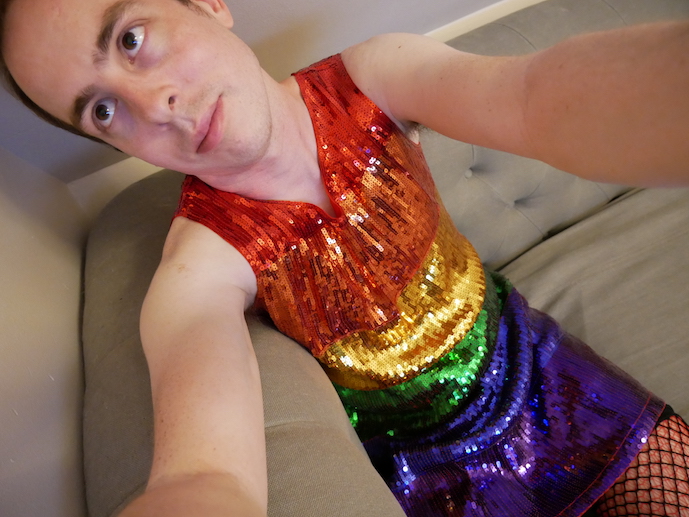Experimenting with drag is fun, but the fun part for me was always to share it with other people. I quickly learned the limitations of the technology I had for achieving the look I wanted to share with the world.
I’ve never been much of a selfie person. For years I enjoyed being a portrait photographer of other people – taking shots at conferences, at parties, at other events – but I never really looked at myself as a subject. (Mostly this is just because I’m old: my photography all evolved before holding a small camera in a single hand was practical.) Over the years, I’ve gotten more used to using a front-facing camera, but I’ve done so largely in the context of video, rather than photos.
When I started playing dress-up, I wanted to share the looks I was going for with others. In part, I did this by just going full rainbow in my live streams; I even added what one of my viewers termed the “creeper-cam” to get a more full view of the look rather than just the talking head. But while video is fun, and offers a lot of opportunities, it didn’t offer the control and posing that I was really looking for. I had images in my head of how the results should look, and video was just the wrong medium for communicating them.
So, I started taking selfies, using my cell phone camera. I quickly realized a major flaw with this approach: The front-facing camera on my phone is not good. In most situations, this doesn’t matter – seeing a photo float by on Facebook at 200px wide, you don’t notice the noise and imperfections that arise from shooting photos from a low-quality camera in indoor lighting. But I wanted more than that: I wanted photos I could be proud of.
I then moved on to trying to use my existing SLR. I’ve been shooting digital photos with a Canon Digital Rebel since 2006: first the XT, later the T3. I have enjoyed the camera, and it’s always been a tool I’ve been proud to use – but I quickly found problems with using it for taking selfies: I had no way of seeing what I was aiming at! The T3 predates the notion that cameras should have flippable screens, so there’s no way to see what you’re taking a picture of when you’re on that side of the lens.
Since I last bought a new camera in 2012, I decided I could probably afford to treat myself to a new camera. I ended up buying a Panasonic Lumix G85 – a micro 4/3rds camera that was better in pretty much every way than my Canon. I did worry for a bit about this: the idea that swapping brands like this was a bad idea is something that is deeply ingrained in my brain from a long history of reading about photography: For most SLR photographers, their investment is in the “glass” – the lenses that they attach to the cameras rather than the cameras themselves. I had to think about it for a while to realize that my ‘collection’ of lenses was pitiful: I had only the Canon kit lens and the 50mm f/1.8 prime lens, and the latter had a minor but annoying scratch that meant all shots were a little bit fuzzy in the middle. In short, I was worrying over pretty much nothing, and ended up migrating to the Panasonic without much trouble.
Now, I could take photos that weren’t completely obscured by noise in the photo sensor! I could take them while seeing what the camera saw. I could take them even in relatively low light. I had a tool at my disposal I hadn’t had before! But quickly this opened into another problem: With higher quality photos, I once again noticed new aspects of the way I looked that didn’t match the look I was going for: the masculine traits (like stubble) that were previously hidden, showed up in these new photos in a way I wasn’t happy about. If I wanted to get deeper into looking pretty, it was time to delve deeper into playing dress-up: It was time to invest in learning something about makeup.
